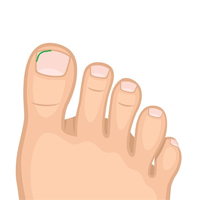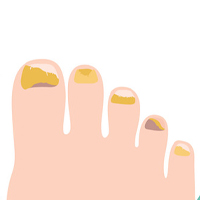Advanced Foot Care
Corner Brook, NL
We offer mobile Foot Care services to clients in Corner Brook and surrounding area.Let A Certified Advanced Foot Care Nurse come to you in the comfort of your own home.
Call Us Today : 709-660-7834


Nail Trimming
Improperly cut or uncut toenails are the perfect place for fungi and bacteria to shelter causing infections.


Callus Removal
Though calluses may look intense, they are actually harmless. If calluses have formed, you won’t need to seek urgent treatment. However, there are ways you can break down calluses for aesthetic purposes.


Nail Fungus Treatment
Toenail fungus is a common and unsightly problem that infects one or more of your toes. If you’ve noticed your toenails have become infected, you should seek treatment right away.
Arthritis is a degenerative disorder of the joints and leads to the progressive loss of cartilage lining the joint surface.
It most commonly affects hands, feet and large joints, such as the knees, hips and spine.
As the cartilage breaks down, movement of the joint is greatly reduced and can cause severe pain and swelling. Arthritis can also be caused by a secondary condition, including diabetes, psoriasis, obesity, gout, etc.
In feet, arthritic joint changes are usually caused by foot and joint deformities, such as hammertoes, bunions, flatfeet, high arched feet or as a result of a trauma to the feet (running, injury, surgery, etc.).
What are the signs and symptoms?
Pain and stiffness of joints
Swelling, cracking and warmth of the affected joints
Formation of bony enlargements within the joint
Difficulty in shoe fitting
Muscle atrophy
Muscle spasm
Athlete’s foot is a fungal infection of the foot, also known as tinea pedis.
It’s a fairly common condition – about 70% of the population will suffer from it in their lifetime and is usually caused by a fungus present in soil.
There are four different fungal dermatophytes that can cause the infection but the most common is trychophyton rubrum.
Anyone can get athlete’s foot but it’s more common in people who are under a lot of stress, wear shoes that don’t fit well, have pedicures at nail salons or go barefoot in warm, wet areas, such as public showers, swimming pools and locker rooms.
The fungus can also spread through direct contact with infected individuals or with objects containing fungal spores such as socks, shoes, etc.
If left untreated, the fungus can spread to other parts of the body, including nails, hands, and legs.
If there is an excessive skin breakdown, a secondary bacterial infection can occur. This is potentially dangerous in individuals diagnosed with diabetes and those with a suppressed immune system.
What are the signs and symptoms?
Infection can occur on any part of the foot but is most commonly found between toes and on the bottom of the foot
The infection might appear wet or dry with redness, scaling, itching and burning but some people have no symptoms and are not aware they have a fungal infection.
A bunion or Hallux abductovalgus (HAV) is a large bump on the side of the big toe.
This bump is caused by the misalignment of the bones causing the big toe to point towards the other toes. It’s common to find the big toe overlapping or resting under the second toe.
Misalignment of the bones is usually followed with arthritic changes within the joint causing pain and discomfort.
Bunions are present in both men and women. However, there is a higher prevalence of bunions in females since this condition is often the result of wearing high heel shoes with a tapered toe box. Bunions are not inherited but they do tend to run in families.
Research indicates that bunions are more common in people with flat feet, which can lead to instability around the big toe joint causing the medial displacement of the first metatarsal bone.
This can lead to the abduction of the big toe (hallux), resulting in the big toe pressing against the second toe.
What are the signs and symptoms?
Pain, mild to extreme, redness, throbbing
Stiffness of the first joint due to arthritic changes within the joint
Turning of the big toe towards the second toe
Development of hammer and claw toes and other soft tissue lesions (callus, corns, bursa, ingrown nails, etc.)
Calluses or hyperkeratotic tissue is a result of high pressure points and friction against the skin.
To prevent further damage to these areas, skin responds by building up layers of thick, hard skin creating calluses.
They usually develop on the plantar surfaces (bottom) of the feet, ball of the foot, heels, or the top of bony protuberances.
If the pressure is not removed, a painful central core or plug of hardened skin forms creating a corn (heloma durum). A callus in combination with a corn can create a painful area.
Anybody can get corns and calluses, but your chances of developing them are higher if you have fallen arches, bunions, hammertoes or arthritis. Wearing shoes that don’t fit properly will also cause friction and high-pressure areas that can lead to calluses and corns.
What are the signs and symptoms?
Corns
Corns consist of deep central layers of cells called a nucleus that can be painful when pressed. The appearance will depend on the mechanical stress and location of the corn.
Hard corns are usually found over high pressure areas (bottom of feet, tip of toes (hammer or claw toes) while soft corns are usually located between toes.
Calluses
Calluses are mostly found in areas that experience a lot of friction and weight bearing pressure, such as the ball of the foot and heel.
They are often larger than corns but can become painful over time as the skin thickens.
People diagnosed with diabetes often suffer from diabetic related foot problems.
In most cases, lack of sensation, weak circulation and foot injuries are the main culprit. Fortunately, most of these problems can be prevented with proper foot care and proper shoe selection.
All individuals diagnosed with diabetes should have their feet checked by a footcare nurse on a regular basis to avoid serious complications.
Assessment should include a vascular and neurological exam. In addition, your skin integrity should also be assessed, especially between your toes and under metatarsal heads.
The presence of heavy callus and warmth may indicate potential breakdown areas. Bony deformities (bunions, hammertoes, etc.), joint mobility, and problems with gait and balance should be immediately addressed through the use of custom orthotics, braces or custom made shoes.
Diabetic foot problems are a leading cause of amputations of the lower limbs.
Worldwide statistics indicate that, every 30 seconds, a limb is lost due to diabetic complications. In most cases, open sores (ulcers) on the bottom of the feet lead to bacterial infection and possible amputation.
However, research indicates that most diabetic foot ulcers are preventable with regulated blood sugar control and regular foot care that addresses all potential factors leading to ulceration.
Anyone with diabetes can develop ulcers, but diabetics who suffer from the following have a greater chance of developing ulcerations and infections:
Uncontrolled blood sugar levels
Peripheral neuropathy
Improper foot care
Impaired circulation
High callus build up, brittle nails and fissured skin
Bunions, hammer and claw toes
Flat or extremely high arches
Exposure to excessive heat or cold
Pressure from a poorly fitting shoe
A fungal nail (onychomycosis) is a fairly common foot condition.
It is estimated that 5% of the population gets fungal nail infections. It causes yellow, thick, scaly and foul smelling nails.
The fungus can be picked up anywhere and it has a tendency to spread quickly and considering that the infection is mostly in the nail bed underneath the nail plate, it is hard to get rid of this infection.
Anyone can get fungal infection, but it’s more common in people under a lot of stress, who wear shoes that don’t fit well or get pedicures at nail salons. People who go barefoot in warm, wet places, such as public showers, swimming pools and locker rooms are also at risk.
The fungus can also spread on direct contact with individuals or with objects containing fungal spores, such as socks, shoes, etc.
Untreated, fungus can spread to other parts of the body, nails, hands, legs, etc. If there is excessive skin breakdown a secondary bacterial infection can occur. This is potentially dangerous in individuals diagnosed with diabetes and those with a suppressed immune system.
What are the signs and symptoms?
Changes in toenail colour (yellowish, green)
Thickening, scaling and crumbling of the nail plate
Presence of odour
Hammertoe is a condition where the middle of the toe bends upward.
Joints at the end or in the middle of the toe may be affected as well, causing the toe to contract and curl into the shape of a hammer.
Hammertoes vary in severity and in the number of joints affected.
Anyone can get hammertoes, but the most common causes are related to faulty foot biomechanics (flat feet or high arched feet), a muscle imbalance, tight fitting footwear, injury, arthritis and diabetes.
What are the signs and symptoms?
A hammer/claw looking toe
Difficulty wearing shoes
Toe stiffness
Pain and difficulty moving your toe
Painful corns and blisters on the top of your toes and feet
Ingrown toenail or onychocryptosis is a fairly common and recurrent foot condition.
It’s usually caused by abnormal external pressure on the nail bed causing the nail edge to grow sideways into the surrounding skin of the toe.
The toe is usually painfully red and infected. Any presence of infection can be very dangerous, especially in people diagnosed with diabetes and those with a suppressed immune system.
Anyone can suffer from ingrown toenails, but they are often the result of improper nail cutting, trauma to the nail, tight shoes, poor posture and gait problems (flat feet), fungal infections and abnormal nail growths, excessive foot sweating (hyperhidrosis), etc.
What are the signs and symptoms?
Skin around the toe nail is shiny, red and tight
Pain at the tip of the toe extending down the side of the nail, especially when pressure is applied
Redness, swelling and thickening of the nail fold, possible presence of infection
Infected area will likely have pus or presence of yellow drainage
Peripheral Neuropathy is a condition that develops as a result of the nerve damage due to some underlying disease.
It is important to understand that peripheral neuropathy is not a disease itself but the symptom of the certain disease that is effecting your body.
The underlying disease can affect one or more nerves at the same time, causing changes in the sensory, motor and autonomic nerves.
Some conditions, such as diabetes, can affect all three types of nerves.
Sensory nerves (the nerves that control sensation) cause tingling, pain, numbness, burning, itching, etc.
Motor nerves (the nerves that allow power and movement) cause weakness in the feet and hands, loss of balance, muscle cramping and twitching.
Autonomic nerves (the nerves that control the systems of the body e.g. gut, bladder) cause changes in the heart rate and blood pressure or sweating.
Peripheral neuropathy caused by diabetes is one of the most common form of neuropathies.
Diabetic neuropathy is a result of the microvascular complications affecting nerves in an ascending manner. This means that the nerve endings furthest from the brain will be affected first.
In a lot of diabetic neuropathies, complications would be first noticeable in toes, feet and then the hands.
Changes in the nerve endings will affect sensation, leading to pain, muscle weakness, balance and can even interfere with sleep patterns. Lack of sensation can be a cause of falls, foot ulcerations and amputations.
The symptoms of peripheral neuropathy will depend on the nerve involved and the level of damage sustained. Some of the most common symptoms are:
Numbness, tingling, pins and needles
Hot/Burning sensation
Abnormally sensitive skin
Electric shock pain
Generalized pain
Muscle weakness
Loss of balance
Neuropathy will generally worsen over time and it can lead to further complications and more pronounced symptoms.
What causes peripheral neuropathy?
Peripheral neuropathy can be caused by many different medical conditions or physical traumas. In some cases, a specific cause cannot be identified and neuropathies with no known cause are know as idiopathic.
Common causes are:
Diabetes
Alcohol and nutritional deficiencies
Infections (HIV, Lyme disease)
Autoimmune diseases
Physical injury
Complications from surgery
Medications (especially chemotherapy)
Plantar warts are one of the most common viral skin infections.
Warts are caused by the human papillomavirus and, just like fungal infections, they are usually acquired through the use of unsterilized tools in nail salons or by walking in bare feet in warm, wet areas, such as locker rooms, public showers and around swimming pools.
They are contagious and care should be taken that they don’t spread to others or to other body parts by touching or scratching.
Anyone can be exposed to plantar warts, however, children, especially teenagers and people with a weakened immune system are more susceptible.
What are the signs and symptoms?
Depending on how deep they are and where they are located, they can be very painful and often appear as thick, rough skin with well-defined boundaries.
In many cases, there are dilated capillaries on the wart, which are usually seen as dark and brown spots within the skin and can appear very small or large in multiple clusters, covering different foot areas
As we age, we tend to have more health problems. Our feet are no exception.
Some foot problems are inherited, but most of them are a result of trauma and years of constant use. Fortunately, most of these problems can be treated so that you can remain active for the rest of your life.
Even a simple task of cutting nails may become a problem due to poor eyesight or difficulty bending down. If the nails are deformed and thick, a footcare nurse can treat them for you and advise you on proper care.
Rejuvenate your feet.
The feet are considered to be the foundation of the body
Poor foot health can impede work performance and even result in lost time from work. And with poor foot health, you're less likely to engage in physical activity. The result is a higher risk of disease, such as heart disease and diabetes, reduced endurance and loss of muscle mass.
Call Us Today : 709-660-7834
Working Hours
- Mon - Fri : 9:00am - 4:00pm
- Sat - Sun : CLOSED


Book a consultation
All first time clients will need an initial foot health assessment upon your first booking.
Call Us Today
709-660-7834
Faq
Frequently Asked Question
We provide foot care for all ages, and all feet.
Absolutely! We are equipped with state-of-the-art instruments, designed specifically to safely and effectively help with thickened toenails or hard calluses.
No. Advanced nursing foot care involves caring for feet apart from cosmetic enhancements such as polish.
Call Us Today
709-660-7834
Contact Us
Stay in Touch and Tell us your Experience
Send us a message with any questions , concerns or feedback and we will get back to you as soon as possible .
info@feetfirstmobile.ca
©2020 Feet First . All Rights reserved

